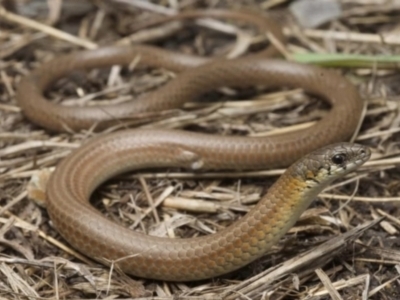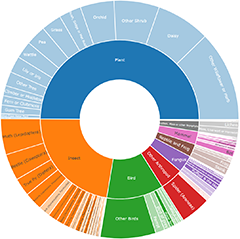Legless Lizards
Australian legless-lizards belong to the family of Pygopodidae which contain 44 species belonging to seven genera: Aprasia, Delma, Lialis, Ophidiocephasus, Paradelma, Pletholax and Pygopus. All are endemic to Australia, except the two species of Lialis, which also occur in New Guinea, one of which is endemic to that island. Pygopodids are not strictly legless since although they lack forelimbs, they possess hind limbs which are greatly reduced to small digitless flaps, hence the often used common names of ‘flap-footed lizards’ or ‘scaly-foot’. The pygpodids are considered an advanced evolutionary branch (clade) of Gecko (Gekkota). Some skinks are also legless.
A common question is how do legless-lizards and snakes differ? In reality legless-lizards and snakes are superficially similar in appearance and behaviour but otherwise have little in common. Snakes have fork tongues (as do monitors) used for sensing the smell of prey whereas legless-lizards have no such apparatus. Legless-lizards have fleshy tongues like most other lizards and like geckos, to whom they are related, can use their tongue to wipe their eyes. Snakes cannot hear but sense vibrations by other animals (prey and predators) nearby. Legless-lizards have ears and can hear. Snakes cannot vocalise but legless-lizards can squeal - this is something they share with geckos who are known for their many and varied calls. Legless-lizards have inflexible jaws and can only eat smaller prey. Snakes can ‘unlock’ their jaws and shallow prey that is much larger. The movement of snakes and legless lizards differ - snakes can push easily along the ground where legless lizards have a side-to-side movement and are much more restricted in their movement (making them more vulnerable). Snakes have short tails and legless-lizards long tails. Snake tails (measured from the snake’s vent to the tip of the tail) are less than ten percent of the length of the body, whereas legless-lizards’s tails may be up to 170 percent of body length, and legless-lizards can also drop their tails if threatened.
A standard measurement in the description of reptiles is the snout-vent length (SVL) which is measured from the tip of the nose (snout) to the anus (vent), and excludes the tail. This is helpful in describing legless-lizards as regenerated tails are rarely as long as the original tails.
A Good Reference in Fauna of Australia.
Announcements
There are currently no announcements.
Discussion
Aprasia parapulchella
Delma inornata
Significant sightings
- Aprasia parapulchella at Hawker, ACT
- Aprasia parapulchella at Chapman, ACT
- Delma impar at Throsby, ACT
- Aprasia parapulchella at Kambah, ACT
- Aprasia parapulchella at Chapman, ACT
- Aprasia parapulchella at Stromlo, ACT
- Aprasia parapulchella at Strathnairn, ACT
- Aprasia parapulchella at Theodore, ACT
- Aprasia parapulchella at Kambah, ACT
- Aprasia parapulchella at Hawker, ACT
Top contributors
- RichardMilner 29
- JasonC 15
- wombey 9
- AaronClausen 8
- DamianMichael 8
- BrianLR 8
- AndyRoo 6
- MPennay 6
- MichaelMulvaney 6
- MatthewFrawley 5
Top moderators
- wombey 78
- GeoffRobertson 48
- WillO 32
- DamianMichael 12
- BrianLR 12
- RichardMilner 11
- MichaelMulvaney 11
- PatrickCampbell 8
- PatrickCampbell2 7
- MichaelBedingfield 5





